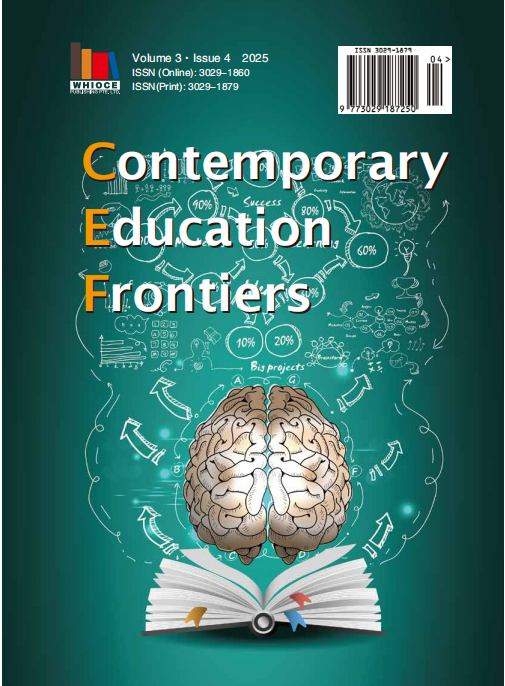Study on the Impact of U.S. High Tariffs on China and the Game Strategies of Export-oriented Enterprises in the Yangtze River Delta Region
DOI:
https://doi.org/10.18063/cef.v3i4.1023Keywords:
U.S.-China trade war, export-oriented enterprises, policy tools, dual circulation, industrial upgrading, trade strategyAbstract
This paper examines the effects of U.S. high tariffs on China's export-oriented firms in the Yangtze River Delta, revealing severe impacts since 2018 due to the trade war. The region, vital to China's export economy, faced heightened costs and trade shifts, prompting firms to adapt through market, industrial, technological, and supply chain strategies.
Drawing on case studies, comparative regional analyses, and policy evaluations, the paper proposes a comprehensive four-dimensional strategy: expanding into emerging markets under the Belt and Road Initiative; leveraging precise policy tools to mitigate tariff burdens; integrating the domestic and international “dual circulation” economic model; and driving innovation to reduce costs and enhance efficiency. The research aims to support policy formulation and offer strategic insights to strengthen export firms’ competitiveness and sustainability. Ultimately, the study provides a practical framework for enterprises to shift from passive reaction to proactive breakthrough in the face of global trade reordering.
References
Gao Ya. Development Dilemmas and Countermeasure Suggestions for China's Export-oriented Enterprises under the Changing International Situation [J]. Modern Marketing (Lower), 2020(11): 238-239.
Li Hong, Ren Jiazhen, Liu Shen. Tariff Reduction of Intermediate Goods in Manufacturing Industry, Institutional Environment and Enterprise Innovation [J]. Modern Finance & Economics (Journal of Tianjin University of Finance and Economics), 2019, 39(7): 80-93.
Ding Yuanhua. Research on Foreign Exchange Risk Management Strategies of Export-oriented Group Companies [J]. Commercial Exhibition Economy, 2024(6): 102-105.
Zhang Ji, Tao Zongxia. The Impact of the Implementation and Withdrawal of U.S. Quantitative Easing Policies on the Chinese Economy [J]. Finance and Management, 2021, 4(12): 22. DOI: 10.26549/cjygl.v4i12.5766.
Vernon N. Hsu, Kaijie Zhu. Tax-Effective Supply Chain Decisions Under China's Export-Oriented Tax Policies, Published Online: 30 Dec 2010. https://doi.org/10.1287/msom.1100.0312
Li Fan, Chang Shiwang, Zhang Wei. Tax policy Tropism of Chinese Enterprises’ Energy Conservation and Pollution Reduction: Evidence from Shandong Province, Energy Procedia, Volume 5, 2011, Pages 2468-2473, ISSN 1876-6102, https://doi.org/10.1016/j.egypro.2011.03.424.
Davin Chor, Bingjing Li, Illuminating the effects of the US-China tariff war on China’s economy, Journal of International Economics, Volume 150,2024,103926,ISSN 0022-1996,https://doi.org/10.1016/j.jinteco.2024.103926.
Loren Brandt, Bingjing Li, Peter M. Morrow,Processing trade and costs of incomplete liberalization: The case of China, Journal of International Economics,Volume 131,2021,103453,ISSN 0022-1996,https://doi.org/10.1016/j.jinteco.2021.103453.
Shi, X. and Xu, Z. (2023), Export tax refund and the misreporting by Chinese exporters. Canadian Journal of Economics/Revue canadienne d'économique, 56: 1469-1489. https://doi.org/10.1111/caje.12679
Fabrice Defever, Alejandro Riaño, Subsidies with export share requirements in China, Journal of Development Economics, Volume 126, 2017, Pages 33-51,ISSN 0304-3878, https://doi.org/10.1016/j.jdeveco.2016.12.003.
Pushan Dutt, Daniel Traca; Corruption and Bilateral Trade Flows: Extortion or Evasion?. The Review of Economics and Statistics 2010; 92 (4): 843–860. doi: https://doi.org/10.1162/REST_a_00034
Feenstra, Robert, C., Wen Hai, Wing T. Woo, and Shunli Yao. 1999. "Discrepancies in International Data: An Application to China-Hong Kong Entrepot Trade." American Economic Review 89 (2): 338–343.DOI: 10.1257/aer.89.2.338
Autor, David H., David Dorn, and Gordon H. Hanson. 2013. "The China Syndrome: Local Labor Market Effects of Import Competition in the United States." American Economic Review 103 (6): 2121–68.DOI: 10.1257/aer.103.6.2121
Loren Brandt, Bingjing Li, Peter M. Morrow, Processing trade and costs of incomplete liberalization: The case of China,Journal of International Economics, Volume 131,2021,103453,ISSN 0022-1996,https://doi.org/10.1016/j.jinteco.2021.103453.
Piyush Chandra, Cheryl Long, VAT rebates and export performance in China: Firm-level evidence, Journal of Public Economics, Volume 102,2013,Pages 13-22,ISSN 0047-2727, https://doi.org/10.1016/j.jpubeco.2013.03.005.

